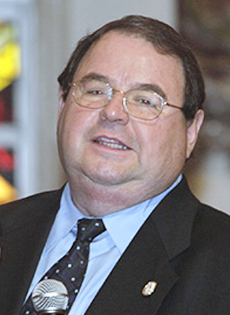
Almost a bishop: The Abbess of Las Huelgas
Monday, March 27, 2017
Rogelio Zelada
"Leonor, by the grace of God and the Holy Apostolic See, Abbess of the Monastery of Santa María la Real de Las Huelgas, Lady, Superior and Prelate, legitimate mother and administrator of the spiritual and temporal in this monastery, most faithful daughter of the Church, the beatitude of His Holiness Pius V..."
The introduction is long and necessary because the Mother Abbess of Las Huelgas has serious matters to discuss with the successor of Peter. It is nothing new in the long history of the great Cistercian monastery, where, since the 12th century, the sitting abbesses undertook serious litigation with the bishops of Segovia and Burgos.
The foundation of the royal monastery is attributed to King Alfonso the Noble and his wife Eleanor of Plantagenet, regents of Castile and Toledo. In 1187, the King, also called the Holy, wanted to build an abbey of Cistercian nuns that would serve as a retreat for the infantas (princesses) of Castile and members of the nobility who wished to "serve God in religion." They would have a place worthy of their high status, social position and birthplace, where they could enjoy themselves "incessantly in the contemplation and praise of God."
The following year, Pope Clement III placed the monastery under the direction of the Apostolic See and, by royal decree, it is exempted from the authority of the Ordinary of the area. From then on, the Abbess, Prelate of Las Huelgas, accumulated so much power and autonomy that she only had above her the authority of the Supreme Pontiff, who had placed her higher than the episcopal curia, with a very similar jurisdiction to that exercised by bishops in their dioceses.
From that moment on, the Mother Abbess of Las Huelgas became Lady of towns and villages, where she exercised full temporal and spiritual powers. She had authority not only over the secular population, but also over the entire religious estate: nuns, friars, priests and pastors of all the parishes in the 54 villages of her ladyship, with their convents, churches and hermitages.
She was the most powerful woman of Castile; there was just one above her throughout Spain, Her Majesty the Queen. It was the Abbess and not the bishop of Toledo who granted the necessary licenses to confess, preach and celebrate Mass and the sacraments. Without the dimissorial letters, signed by her own hand, no one could access the sacrament of the Order.
For seven centuries, her power was not only recognized but also increased by pontiffs such as Clement III, Honorius III, Innocent IV, Alexander IV, Pius V, Sixtus V, Urban VIII, Leo X, Innocent VIII and Clement XII, among others.
During the Middle Ages, the Royal Monastery was the site chosen for the coronation of the monarchs of Castile and the place where these and other members of the nobility were knighted. It was the favorite space to celebrate magnificent royal weddings, bonds and burials of the upper Castilian nobility.
The Lady Abbess could appoint mayors and judges, administrators and clerks; deal out justice and control the two prisons inside the monastery, one for ecclesiastics and another for lay people. Her power and prestige were such that in the 14th century Pope John XXII granted her powers "to fulfill censures against anyone who holds or usurps property, houses, possessions, lands, rights and prerogatives of the monastery."
Another 12 monasteries of Cistercian nuns were under the authority of Las Huelgas, whose Abbess attended and approved the election of prioresses in all convents under her jurisdiction. She confirmed, or not, the new abbesses and named all the major and minor appointments and offices. She could change and transfer nuns and abbesses from one monastery to another, and it was not possible to admit new nuns, receive the veil or profess without her permission.
The ladyship and privileges of the Abbess of Las Huelgas remained intact until the 19th century, when Pope Pius IX reformed the situation of all the exempt territories that remained in Spain and Europe. The Bull "Quae Diversa" suppressed the ecclesiastical jurisdiction that the monastery had on people, towns, parishes and convents, and placed the monastery of Las Huelgas under the authority of the archbishop of Burgos.
The prelate of Las Huelgas, with her "quasi episcopal vere nullius" powers, is an interesting case that tells us about the role that women have had at some point in the history and life of the Church. She was a female figure who, for over 700 years and with the support of the Roman pontiffs, ruled an extensive territory, almost like a bishop, with vast powers and faculties now unimaginable.
The abbesses of Monteviliers in Normandy, of Wadstena in Sweden, of Luca and St. Benedict of Conversano in Italy, exercised their authority in a very similar way. The latter had a vicar general who was a bishop, and she wore pontifical gloves and sandals, ring and pectoral, miter and staff to receive the homage of the clergy in her territory. The last abbess of Conversano, who died in 1809, was buried with miter, brimstone, staff and other insignia of a bishop. However, none of these reached the splendor of the abbess of Las Huelgas.
Thus, in the 16th century, Cardinal Aldobrandini joked with his uncle, Pope Clement VIII, alluding to an already popular proverb: "Reverence aside, if the Supreme Pontiff, head of the Church, would have to marry, there would be no woman more dignified than this Abbess, for the rare and superior dignity that makes her so illustrious."

